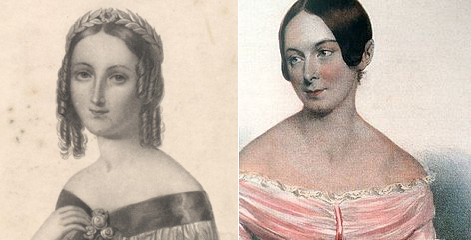In a letter to his brother Johann on 8 September 1822, Beethoven wrote:
Two women singers called on us today and as they absolutely insisted on being allowed to kiss my hand, and as they were decidedly pretty I preferred to offer them my mouth to kiss.
These two singers were very likely the 16-year-old soprano Henriette Sontag and 18-year-old contralto Karoline Unger. Two years later they were to sing in the first Viennese performance of excerpts of the Missa Solemnis and the premiere of the 9th Symphony.

In the fall of 1822, an old acquaintance of Beethoven’s, dramatist and theater manager Carl Friedrich Hensler, was working to reopen the Josephstadt Theatre in Vienna following renovations. The opening was scheduled for 3 October, the name day of the Emperor.
For the opening ceremony, Carl Meisl, a Commissioner of the Royal Imperial Navy, adapted the texts that August Kotzebue had written for Beethoven’s “The Ruins of Athens” that opened an imperial theater in Pest in 1811 (Day 249), and he added some new texts.
These changes required Beethoven to revise some of “The Ruins of Athens” music, and to add an additional number. He also decided to write a new overture. This revamped composition is known as “Die Weihe des Hauses” or “The Consecration of the House,” i.e., the theatre.
Beethoven’s complete “Consecration of the House” is catalogued as Hess 118. It consists of a mix of old, new, and revised music. Three parts of this work were published separately:
Opus 124. Overture
WoO 98. “Wo sich die Pulse” for soprano and chorus
Opus 114. March and Chorus
Following the new overture (Op. 124), “The Consecration of the House” consists of nine musical numbers. The following list from The New Hess Catalog of Beethoven’s Works (Vance Book Publishing, 2003), p. 79, shows how these numbers correspond to “The Ruins of Athens”:
- 1: Ruins of Athens No. 1 with new text
- 2–4: Ruins of Athens Nos. 2–4
- 5: “Wo sich die Pulse” (WoO 98)
- 6: Ruins of Athens No. 6 March and Chorus (Op. 114)
- 7: Ruins of Athens No. 5 with shortened text
- 8–9: Ruins of Athens Nos. 7–8 with partly new text
#Beethoven250 Day 328
The Consecration of the House (Hess 118), 1822
A studio recording features the Overture, “Wo sich die Pulse” for soprano and chorus, the March and Chorus, and (bonus track) “Ruins of Athens” No. 5 with offstage winds.
The new Overture that Beethoven wrote for “The Consecration of the House” is frequently and accurately described as “Handelian,” perhaps influenced by Beethoven’s explorations of Baroque music during the composition of the Missa Solemnis. It is sometimes performed in concert.
#Beethoven250 Day 328
The Consecration of the House: Overture (Opus 124), 1822
A vibrant live performance of the Overture by the Hungarian Philharmonic under Zoltán Kocsis.
#Beethoven250 Day 328
The Consecration of the House: “Wo sich die Pulse” (WoO 98), 1822
A rare live performance of this song celebrating dancing youths, appropriately played and sung by Viennese youths.
The only difference between the No. 6 March and Chorus in “The Ruins of Athens” and the No. 6 March and Chorus in “The Consecration of the House” seems to be that the latter does not have narration. This latter version is the one published separately as Opus 114.
The Opus 114 March and Chorus is called “Schmückt die Altäre!”:
Deck the altars! – They have been decked.
Spread incense! – It has been spread.
Pick roses! –They have been picked.
Wait for those who are coming! – We are waiting for them to come.
Be ready! – We are ready.
#Beethoven250 Day 328
The Consecration of the House: March and Chorus (Opus 114), 1822
An ad may precede this studio recording of the March and Chorus from an album that includes both versions.
During performances of “The Consecration of the House” in October 1822 is apparently when Beethoven first became closely acquainted with violinist Anton Schindler, who later wrote an early (although notoriously unreliable) biography of Beethoven.